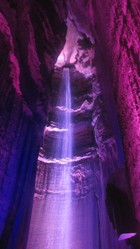The author's main idea was that the surface of the ground lies in dynamic interaction with what lies beneath, and this is so in both rural places and the modern world. His case is that cultures exist in interaction with what is below.We use the underland for the following purposes: to protect what is valuable and to be preserved; to find what is valuable [e.g.a mine] and to conceal evils that we don't want to escape.
An important literary technique recurs in this work is the line that begins the book,"The way to the Underland is through the riven trunk of an old ash tree."He then takes readers on an imaginary journey through time, through the ash tree portal, giving verbal snapshots of characters and events whose memory is stored below. Those with knowledge of mythology will instantly pick up the allusion to the mythological ash tree Yggdrasil, in Norse mythology, whose roots descended to the nether regions, whose trunk was in Middle Earth and whose canopy was in heaven.
Macfarlane early in the book investigates the soil of Epping Forest,near London, where he camps at night and tries to fathom the intricate networks of fungal hyphae and plant roots on which he ecosystem depends. This endeavour is the first stage in what is a polymathic compendium that takes us through Earth sciences, archaeology and history,mythology and at times physics.. The author expounds his scholarship in the lucid prose of one at ease with his command of knowledge.
The underland of cities, such as London and Paris, fascinates him, and in London he embarks on ventures with urban explorers, finding the neglected tunnels that lace our sprawling metropolis.This is a fascinating enterprise that exposes the forgotten side of our cities.But his urban exploring takes.him down deep mines on the North York Moors on England's north east coast. There are two things happening here, one is a potash mine with enough of this vital plant nutrient to last at least a hundred years,maybe five hundred, The second is a physics research lab that is set deep so as to detect neutrinos, subatomic particles that have proved elusive to find. We discover what it is like to work deep underground in a soft deposit whose roof is ever in danger of sagging.
The author brings out the link between the underland and war, and this is particularly so when he ventures into the Julian Alps, which are in Slovenia and which were the scene of bloody fighting between Italian and Austrian forces in World War One. We see how shelters were cut in rock and ice for the participants in this conflict, some of which are becoming exposed as glaciers melt through global warming. We also read of the small , but still tragic, number of people killed in the Slovenian woods when unexploded shells ignited in the forest fires of a dry summer, a grim legacy of an unnecessary and wanton conflict.








 Pilgrimage. A reviewon 06/15/2025
Pilgrimage. A reviewon 06/15/2025
 Leo the Fourteenthon 05/09/2025
Leo the Fourteenthon 05/09/2025
 The Melsonby Hoardon 03/25/2025
The Melsonby Hoardon 03/25/2025




Comments
The disposal of short,term waste is under review at the present time, so I cannotb say much about it.
Thank you for your comment below in answer to my previous observation and question.
Your comment three boxes down associates long-term storage of "very radioactive" material with burial and short-term waste with short-term surface storage.
Do short-term materials always remain on the surface or might they be relocated elsewhere when they show even less or no radioactivity?
Long term is what timescale is needed to store very radioactive material.
Thank you for your comment below in answer to my previous observation and question.
The terms long and short term intrigue me.
Might the aforementioned terms refer to storage or to waste timespans?
Long termis always buried, SHORT term can stay on the surface.
Thank you for your comment below in answer to my previous observation and question.
A storage unit for nuclear waste could have either an above- or a below-ground component for nuclear waste in the United States.
Which would it be in the British Isles?
Rocksbthat are liable to collapse. There are several causes, erosion quake
Thank you for your comment below in answer to my previous observation and question.
What is "geological instability"?
Might it refer to earthquakes?
Online sources present the British Isles as prone to magnitude-4 earthquakes every 2 years and magnitude-5 earthquakes every 10-20 years!
The nuclear power station at Hinckley Point not far from the Mendips has a small storage unit for nuclear waste. West Cumbria was chosen because it is near a nuclear power station and is not prone to coastline erosion or geological instability.
Revisiting your wizzley brought to mind something that I'd meant to explore earlier, with the first reading.
It intrigues me where your say "Macfarlane's literary and physical journey, which began in the Mendip Hills at the palaeolithic burial site of Aveline's Hole, a natural cave used to inter the valued dead, is now completed, ironically with an unnatural hole in which we try to seal away the dangerous waste that our ecologically wasteful lifestyle has left us."
What is the name of that waste disposal point?
In a related direction, it's a bit confusing on the internet to determine whether you all northeast ponders store nuclear waste above- or below-ground or both! Why was west Cumbria selected for radioactive-waste storage? Would the Sellafield facility still be the main or only storage point?